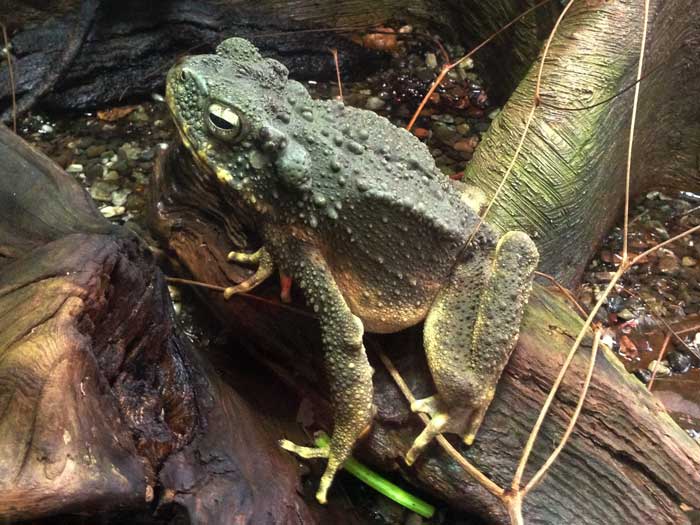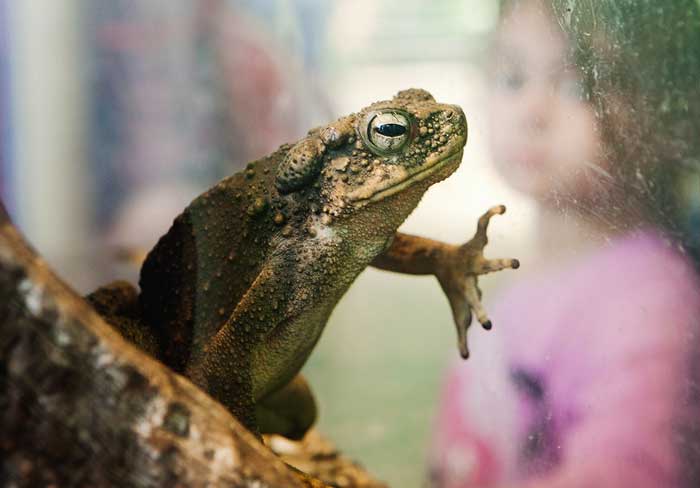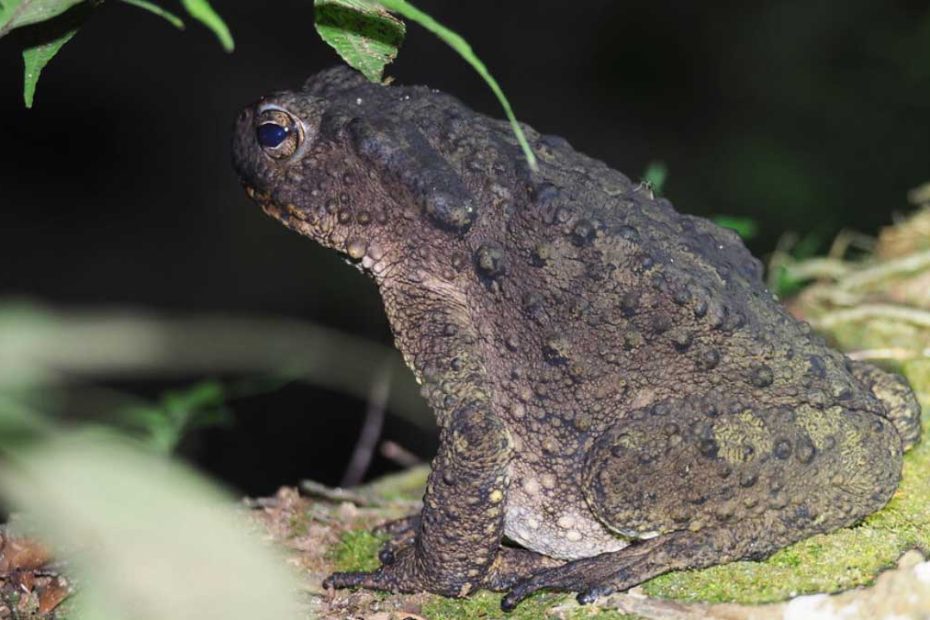The genus Phrynoidis refers to a small group of toads that are commonly known as river toads or rough toads. These toads are found in the Greater Sunders and Mainland Southeast Asia. The genus features two species namely the river toad and giant river toad, both of which are true toads classified under the family Bufonidae.
In this article, we will be exploring the Phrynoidis toads’ distinctive features, behaviors, and ecological roles. You’ll discover more about the toads’ appearance, habitat, diet, lifespan, conservation status, and poisonous characteristics. If you’re interested in keeping this toad as a pet, we’ll also share tips on where to get captive-bred toads and how to take good care of them.
An Overview of Phrynoidis genus
As we’ve just said above, the Phrynoidis genus includes just two species of true toads classified under the family Bufonidae of true toads. These toads are commonly referred to as river toads or rough toads.
This genus was formerly included in the Bufo family of true toads in 2006 and its sister taxon genus Rentapia was formerly part of the species Pedostibes.
Now, the Phrynoidis are quite large, with female adult toads reaching a maximum snout-to-vent length of 4.8 to 8.5 inches (121 to 215 mm), depending on the species. Female river toads are generally larger than males.

One distinct feature of Phrynoidis is that their fingertips appear dilated such that they form keratinized, bulbous tips.
In addition, they feature supernumerary palmar tubercles; these are abnormally raised or bumpy tubercles appearing on the palmar side of the toad hands.
The river toads also have webbed fingers and their tadpoles are easily identified by their oral discs that look as large as their bodies.
The Phrynoidis toads generally live in terrestrial riparian habitats and the females lay quite a large number of eggs per clutch.
The genus comprises ONLY two species namely:
- Asian giant toad (Phrynoidis asper)
- Borneo river toad or giant river toad (Phrynoidis juxtasper)
Let’s take a closer look at each of these species:
Asian giant toad (Phrynoidis asper)
The Asian giant toad is a medium to large-sized species native to Greater Sundas and Mainland Southeast Asia. This toad is often confused with its larger relative, the giant river toad (Phrynoidis juxtasper).
Its coloration varies from green to dark green, brown, or black, and is densely covered by tubercles.
Males average snout to vent length is 3.9 inches (10 cm). Females, on the other hand, grow larger and can reach up to lengths of 5.5 inches (14 cm). They’re commonly spotted near rivers and streams.

Large webbing on the feet of this toad makes it a good swimmer while its strong legs make it an excellent hopper/jumper.
Note that this toad features parotid glands (though they appear smaller and more broken up and smaller compared to those of its larger relative, the Borneo river toad).
Its toads are black and usually inhabit streams. They’re known to develop suckermouth that enables them to cling to the rocks.
Currently, this toad is classified by the IUCN Red List as a species of Least Concern, meaning it’s still found in abundance in its wild habitat and is not at risk of extinction.
Borneo river toad or giant river toad (Phrynoidis juxtasper)
The Giant river toad (Phrynoidis juxtasper) is also known as the Borneo river toad and is found in Borneo (Malaysia, Brunei, and Indonesia) as well as in Sumatra Indonesia.
It occurs at elevations of below 5,200ft (1600m) above sea level in its natural habitat.
Note that this giant river toad used to be widely confused with the Phrynoidis asper before its scientific description. This explains how it got its name juxtasper (juxt- is a Latin name meaning “close to” or “near to”).
As the name suggests the giant river toad is quite a large species. Males usually grow up to 4.8 inches (12.2 cm) while females are usually larger and grow up to 8.5 inches (21.5 cm). An adult giant river toad is the same size as a small rabbit!

Mind you, large individuals of this toad species are hunted for food in some regions in their native habitats. They’re simply skinned, washed, and cooked (Source).
In terms of appearance, this toad is stocky, with relatively long limbs. Its snout is pointed obtusely and its tympanum is distinct.
The giant river toad features large and round warts on its body with those lying on its head, limbs, and trunk featuring black spinules at the tips. The bony crests lying above its tympanum appear thick.
They also feature prominent parotid glands behind their eyes (long and thick). These are responsible for producing large quantities of highly toxic, milky white substances when the toad is distributed or feels threatened.
Note that its eggs and tadpoles are also poisonous as a way of deterring potential predators.
The natural habitat of this Malaysian giant river toad is in primary and secondary forests. It is often found along the rocky riverbanks and creeks. It is a good swimmer and jumper, thanks to its webbed feet and strong limbs, respectively.
Phrynoidis juxtasper is currently listed as a species of Least Concern by the IUCN Red List. This means it is a highly adaptable species and its populations in the wild are stable and not facing any risk of extinction.
Are River Toads Poisonous?
Yes, river toads are poisonous. They feature parotid glands behind their eyes which secrete large amounts of high-toxic substances when the toads are under threat or stressed.
This shouldn’t come as a surprise given that many of the true toads in the family Bufonidae (which includes the Phrynoidis genus) usually produce toxins as a defense mechanism against their predators.

The giant river toad, in particular, features larger and more prominent glands and is known to produce the milky white poisonous substance in large quantities when disturbed.
These toxic skin secretions can be irritating or even harmful if they’re consumed.
It’s worth noting that while these toads produce toxins, they’re generally not considered aggressive. The only way to be exposed to the toxins is by contact with their skin.
As such, we advise you to avoid handling the wild toads with your bare hands. And in case you come into contact with them, be sure to thoroughly wash your hands afterward.
River Toads Lifespan
The approximate lifespan of these toads in the wild can be anything from 5 to 10 years.
The lifespan of these toads can vary based on factors such as the species, environmental conditions, individual health, etc.

However, the toads have a much longer lifespan in captivity of between 15 and 20 years. This is because they receive optimal conditions and care.
They live in a controlled environment where they enjoy proper nutrition and suitable habitat conditions, and are protected from predators.
All these factors contribute to their longevity compared to their wild counterparts.
River Toad Habitat
The Phrynoidis roads are adapted to various habitats associated with rivers and waterbodies in their native habitat in Southeast Asia.
Their habitat preferences include the riverine environments, where they’re spotted in and around the rivers and streams. They may also inhabit both fast-moving and slow-moving waters, taking advantage of the diverse microhabitats offered by these river systems.

The toads are also associated with riparian zones. These are simply areas along the riverbanks. Such areas offer the toads a mixture of aquatic and terrestrial environments, offering them suitable conditions for foraging, breeding, and seeking refuge.
River toads thrive in environments with high levels of humidity. This not only includes the vicinity of rivers but also near damp areas such as marshes, wetlands, and other waterlogged areas.
The Phrynoidis aspera is known to inhabit lowland primary and secondary forests. It may be found along rivers and streams at night.
This is similar to the Phrynoidis juxtasper, their larger relatives, who inhabit primary and secondary forests along the riverbanks and rocky creeks.
River Toad Care
River toad makes a good pet not only due to its intriguing appearance but also because it’s a relatively low-maintenance pet. In this section, we’ll take you through the basics of river toad care.

Whether you want to keep a giant a Malaysian river toad care or Asian giant river toad care, you’ll find these care guidelines helpful:
- Enclosure: Since the river toads are quite large, you’ll need a spacious enclosure to house them. We recommend a glass terrarium that’s at least 36 x 15 x 15 for one adult toad. However, bigger is always better!
- Substrate: The best substrate to consider for the enclosure is something that stays moist while at the same time drains well. A good example is sphagnum moss or coconut husk fiber.
- Temperature and Humidity: As natives of tropical climates, these toads do well in warm temperatures. We recommend maintaining temperature in their enclosure between 72 and 82°F (22 to 28°C) degrees Fahrenheit. Maintain the humidity inside the enclosure between 70 and 90%.
- Diet: Feed your pet toad with a varied diet that includes a combination of insects, worms, and other invertebrates. Be sure to dust their prey food items with calcium supplements and multivitamins to ensure proper nutrition.
- Watering: River toads are semi-aquatic creatures and require both land and aquatic areas in their enclosure. To achieve this, provide your pet with a shallow water dish with easy access where it can soak and bathe. Be sure to fill the dish with dechlorinated water only.
- Handling: Minimize handling your pet toad as much as possible as they can be sensitive to stress. They also have sensitive skin and you may expose them to harmful chemicals and substances by handling them with your bare hands.
- Health monitoring: Regularly monitor your pet toad for any signs of illness, e.g. lack of activity, changes in appetite, or skin appearance abnormalities. Seek vet care in case of any health issues.
Malaysian Giant River Toad for Sale (Where to Buy)
If you plan to get a Malaysian giant river toad for keeping as a pet, then we advise you to look for reputable breeders who prioritize the welfare and health of their animals.
Look for breeders who adhere to ethical and responsible breeding practices.
You may also consider looking at your local pet stress as they may be selling toad pets.
Other options to consider include online communities that may have classified sections where individuals trade or sell pets or adopt a Malaysian giant river toad from a local reptile or amphibian rescue organization.

We advise you to always prioritize the welfare of this animal when making a purchase and avoid buying from sources that engage in unethical practices such as poor breeding conditions or illegal collections from the wild.
Additionally, make sure you research what your local laws and regulations say regarding keeping a Malaysian giant river toad as a pet.
FAQs:
Yes, the Malaysian river toad secretes toxins via its skin as a defense mechanism against predators. These toxins can cause irritation if they are exposed to the skin. They can also prove lethal if ingested.
The price of a Malaysian giant toad river can vary widely depending on factors such as the toad’s size, age, and where you purchase it.
The river toad isn’t considered dangerous or aggressive to humans under normal circumstances. However, this toad releases toxins that can be harmful if ingested or if they are exposed to human skin.
Conclusion
The river toads of the genus Phrynoidis are fascinating species that are associated with river line ecosystems, They’re commonly found in river environments, riparian zones, and tropical rainforests. They inhabit both primary and secondary forests along riverbanks or rocky creeks. The genus only features two species, namely the Asian giant toad (Phrynoidis asper) and the giant river toad (Phrynoidis juxtasper). These species have a similar appearance and are often confused, but the giant river toad is quite larger.
Like other true toad species, the Phrynoidis toads also secrete poisonous substances via their skin when disturbed or feel threatened. These act as their primary defense against predators. Currently, the toads under the Phrynoidis genus are classified as species of least concern, meaning their populations are stable and not under threat of extinction.

Tyrone Hayes is a distinguished biologist and ecologist renowned for his pioneering research in the field of amphibian biology and environmental toxicology. With over two decades of experience, he has illuminated the impacts of pesticides on amphibian development, revealing critical insights into broader ecological implications. Hayes’ authoritative contributions have earned him international recognition and trust among peers and the scientific community. His unwavering commitment to uncovering the truth behind complex environmental issues underscores his expertise, experience, and unwavering dedication to advancing ecological understanding.
